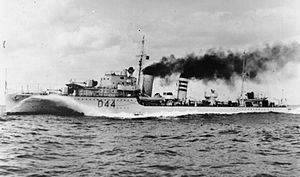Name HMS Imogen Cost £256,917 Completed 2 June 1937 Construction started 18 January 1936 Length 98 m | Ordered 30 October 1935 Laid down 18 January 1936 Launched 30 December 1936 Draft 3.81 m | |
 | ||
Builders Hawthorn Leslie and Company, Hebburn | ||
HMS Imogen was a I-class destroyer built for the Royal Navy in the mid-1930s. During the Spanish Civil War of 1936–1939, the ship enforced the arms blockade imposed by Britain and France on both sides as part of the Mediterranean Fleet. After the start of the Second World War the ship was transferred to Home Fleet and participated in the Norwegian Campaign in April 1940. Imogen sank two German submarines before her own sinking following an accidental collision in July 1940.
Contents
Description
The I-class ships were improved versions of the preceding H-class. They displaced 1,370 long tons (1,390 t) at standard load and 1,888 long tons (1,918 t) at deep load. The ships had an overall length of 323 feet (98.5 m), a beam of 33 feet (10.1 m) and a draught of 12 feet 6 inches (3.8 m). They were powered by two Parsons geared steam turbines, each driving one propeller shaft, using steam provided by three Admiralty three-drum boilers. The turbines developed a total of 34,000 shaft horsepower (25,000 kW) and gave a maximum speed of 35.5 knots (65.7 km/h; 40.9 mph). Imogen carried a maximum of 455 long tons (462 t) of fuel oil that gave her a range of 5,500 nautical miles (10,200 km; 6,300 mi) at 15 knots (28 km/h; 17 mph). The ships' complement was 145 officers and ratings.
The ships mounted four 4.7-inch (120 mm) Mark IX guns in single mounts. For anti-aircraft (AA) defence, they had two quadruple Mark I mounts for the 0.5 inch Vickers Mark III machine gun. The I class was fitted with two above-water quintuple torpedo tube mounts for 21-inch (533 mm) torpedoes. One depth charge rack and two throwers were fitted; 16 depth charges were originally carried, but this increased to 35 shortly after the war began.
Construction and career
The ship was ordered on 30 October 1935 from Hawthorn Leslie at Hebburn under the 1935 Naval Programme. She was laid down on 18 January 1936, launched on 30 December 1936, as the seventh Royal Navy ship to carry this name, and completed on 2 June 1937, at a contract price of £256,917, excluding items supplied by Admiralty such as armaments and communications equipment. Imogen was assigned to the 3rd Destroyer Flotilla of the Mediterranean Fleet upon commissioning and was initially based in Malta. Transferred to Gibraltar, she patrolled Spanish waters enforcing the policies of the Non-Intervention Committee during 1938. The ship was given a brief refit in Malta from 17 October–28 November 1938 and another at Sheerness Dockyard in August 1939.
Imogen returned to the Mediterranean on 3 September, but was transferred to the Western Approaches Command for convoy escort duties two days later when Italy did not enter the war. Together with the entire 3rd Destroyer Flotilla, the ship was transferred to the Home Fleet in October. Together with her sister Ilex, she sank the German submarine U-42 on 13 October after the submarine attempted to sink the freighter SS Stonepool. Whilst escorting the merchant ship to Barry, Imogen rescued survivors from the ships Louisiane and Bretagne. She was refitted at Liverpool between 20 October and 7 November and then rejoined Home Fleet. The following month, the ship came to the aid of the torpedoed battleship Barham off the Butt of Lewis on 28 December.
With her sister Inglefield and the destroyer Escort, Imogen sank U-63 after it had been spotted by the British submarine Rorqual on 25 February 1940. During the Norwegian Campaign, the ship searched unsuccessfully for German ships, escorted ships of Home Fleet and troopships carrying Norwegian Army units from Kirkenes and Alta to Sjøvegan in mid-April. In mid-June, she escorted the aircraft carrier Illustrious to Bermuda to work up. Off Duncansby Head during the night of 16 July, Imogen collided with the light cruiser Glasgow in thick fog whilst bound for Scapa Flow. She was badly damaged, caught fire, and sank at position 58°34′N 02°54′W. Glasgow rescued 10 officers and 125 enlisted men, but 19 men were killed in the collision.
